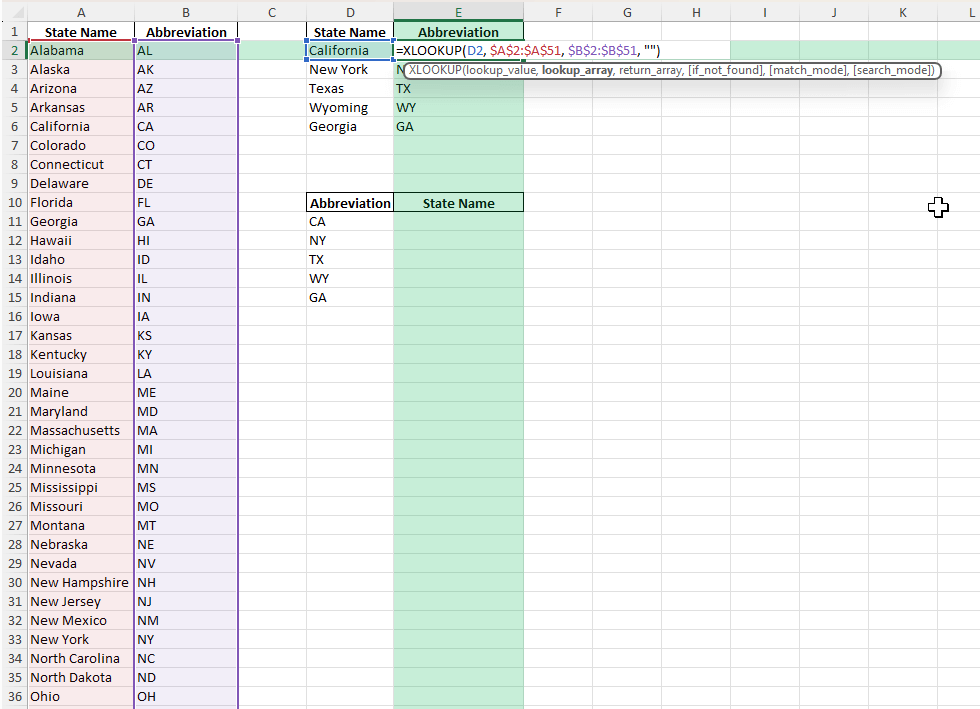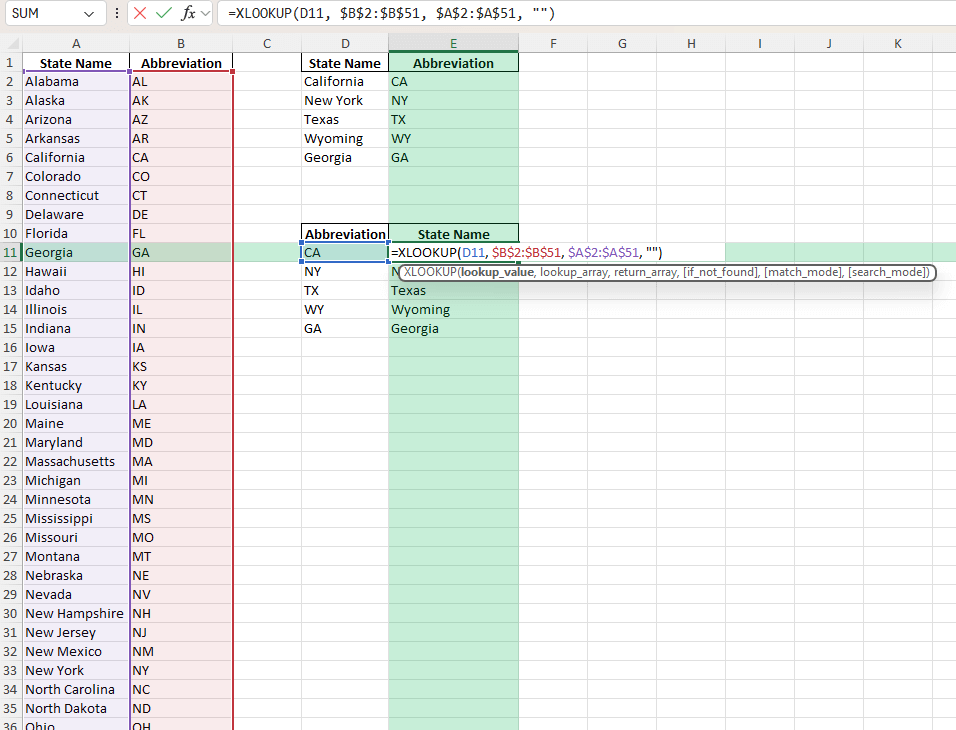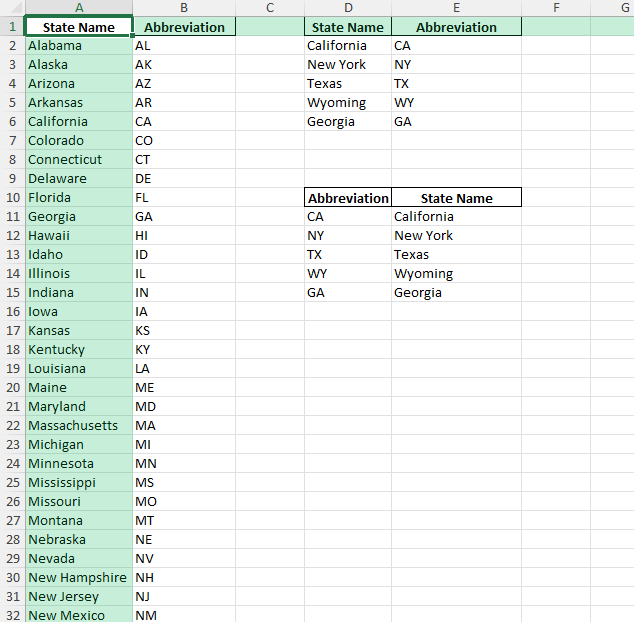If you work with U.S. data in Excel, you’ve probably come across state names and their two-letter postal abbreviations. Whether you’re standardizing addresses, analyzing regional sales, or building dashboards, having a reliable way to convert between state names and abbreviations is essential. This post walks through practical ways to work with the 50 states abbreviations in Excel, including ready-to-use formulas, tips, and downloadable resources.
Key Takeaways
- You can create a lookup table for all 50 states and abbreviations in Excel for quick reference or automation.
- Use VLOOKUP or XLOOKUP functions to convert between state names and abbreviations automatically.
- Data validation helps users select only valid states or abbreviations in your sheets.
- Power Query can import, clean, and standardize state data from external sources efficiently.
- Automate repetitive tasks with VBA or formula-driven lists for faster data entry and error reduction.
Table of Contents
About 50 States Abbreviations in Excel
The United States Postal Service (USPS) created a standard two-letter abbreviation for each state, making it easy to keep records short and consistent. In Excel, you can store these pairs in a table and use lookup functions to translate between the full state name and its abbreviation.
For example, California becomes CA, and New York becomes NY. This is especially useful for data cleaning, imports, address verification, and business reporting.
Streamlining Data Entry
Using state abbreviations can significantly speed up data entry in Excel. With shorter inputs, you reduce the time spent typing and the room for error. This can be particularly beneficial when dealing with large datasets or when multiple team members are involved. By adopting a uniform abbreviation system, you ensure each entry is quick and consistent, making it easier to focus on the analysis rather than the data entry process itself.
Enhancing Database Organization
Incorporating state abbreviations into your Excel databases enhances organization by making data cleaner and more manageable. This uniformity allows for easier sorting and filtering of data, particularly when you’re working with national-level datasets. With standardized abbreviations, merging datasets from different sources becomes simpler, reducing the likelihood of discrepancies. This organized approach also supports advanced database functionality, such as pivot tables and VLOOKUP, ensuring accurate and efficient data manipulation.
Step-by-Step: Building and Using 50 States Abbreviations in Excel
Step 1: Create a Lookup Table
In a blank worksheet, enter the following columns:
- State Name
- Abbreviation
Paste the 50 states and their abbreviations:
(A downloadable sheet is included with all 50 states filled in.)
Step 2: Lookup Abbreviations from State Names
Suppose you have state names in column D (D2:D6). To get abbreviations in E2, enter:
=VLOOKUP(D2, $A$2:$B$51, 2, FALSE)
or, with XLOOKUP (Excel 365 and Excel 2021):
=XLOOKUP(D2, $A$2:$A$51, $B$2:$B$51, "")
Drag the formula down to fill in the rest.
Step 3: Lookup State Names from Abbreviations
Suppose abbreviations are in column D (D11:D15). Enter:
=VLOOKUP(D11, $B$2:$A$51, 2, FALSE)
or, using XLOOKUP:
=XLOOKUP(D11, $B$2:$B$51, $A$2:$A$51, "")
Common Mistakes and Tips
Mistake: Misspelling state names or abbreviations, causing lookup errors.
Tip: Use data validation and/or copy-paste official USPS lists to reduce mistakes.
Mistake: Forgetting to make lookup table references absolute (using $ symbols) in formulas.
Tip: Use $A$2:$B$51 instead of A2:B51.
Mistake: Case sensitivity in custom formulas.
Tip: Standard Excel lookup functions are not case-sensitive, but always check your source data.
Tip: Remove extra spaces in source data with =TRIM(A2).
Tip: Add conditional formatting to highlight invalid or missing entries.
Bonus Tips and Advanced Scenarios
Power Query: Import state lists from external sources, deduplicate, and merge with other datasets.
VBA Example:
Sub AbbrevToState()
Dim dict As Object
Set dict = CreateObject("Scripting.Dictionary")
Dim i As Long
For i = 2 To 51 'Assume table starts in row 2
dict(Cells(i, 2).Value) = Cells(i, 1).Value
Next i
For i = 2 To 10 'Change as needed
If dict.Exists(Cells(i, 6).Value) Then
Cells(i, 7).Value = dict(Cells(i, 6).Value)
End If
Next i
End Sub
Dynamic Arrays (Excel 365): Use =FILTER() or =UNIQUE() to work with custom lists.
Beyond the Basics: Exploring Territories and Commonwealths
Including U.S. Territories in Your Data
While state abbreviations often take center stage, U.S. territories should not be overlooked in comprehensive datasets. Territories like Puerto Rico (PR) and Guam (GU) have distinct postal codes that are important for inclusive data management and analysis. Including these territories ensures your dataset is complete and accurately reflects all U.S. jurisdictions. This inclusion can be especially crucial for organizations with a national outreach or those analyzing federal data. By treating these territories with the same attention as the 50 states, you can maintain consistency and comprehensiveness in your records.
Handling Exceptions and Special Cases
Excel users must be prepared to handle exceptions and special cases when using state abbreviations. These might include addresses with unique ZIP codes like those for military installations, which don’t align strictly with state lines. In such cases, it’s essential to verify the correct abbreviation or code from reliable sources like the USPS. Additionally, consider fringe cases such as states with shared names or regions outside the U.S. Ensure your dataset allows for these special cases by implementing a flexible yet structured approach—perhaps through a notes column for clarification.
FAQ
Q: What are the 50 state abbreviations in Excel?
A: See the downloadable workbook below for a ready-to-use list of all state names and abbreviations.
Q: How do I convert full state names to abbreviations in Excel?
A: Use VLOOKUP or XLOOKUP with a lookup table.
Q: How can I restrict input to valid state abbreviations?
A: Use Data Validation with a list source.
Q: Can I do this in older versions of Excel?
A: Yes, all solutions here work in Excel 2010 and later.
Q: How do I use this for addresses imported from another system?
A: Power Query can standardize and map state names and abbreviations automatically.
John Michaloudis is a former accountant and finance analyst at General Electric, a Microsoft MVP since 2020, an Amazon #1 bestselling author of 4 Microsoft Excel books and teacher of Microsoft Excel & Office over at his flagship MyExcelOnline Academy Online Course.











